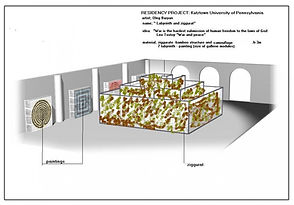Oleg
Buryan
Labyrinth and Ziggurat
Symbols are not only one of the most ancient expressions of art, they an integral part of modern life. They can be exceptionally diverse in their meaning. A simple cross can represent an entire theology, a way of life and the complex iconography that is involved within the bounds of the meaning of this symbol. Also logos of companies, political parties, or of a headache pills can inspire trust and confidence, or mistrust and deception. There are international symbols to inform us of the road conditions ahead, at airports or at railway stations to tell us where to put our luggage, the location of the lifts, and where to go to get tickets. We accept these symbols as an extension to our language.
God's Etemenanki (Sumerian É.TEMEN.AN.KI "temple of the foundation of heaven and earth") was the name of a ziggurat dedicated to Marduk in the city of Babylon of the 6th century BCE. Ziggurats were a form of temple common to the Sumerians, Babylonians and Assyrians of ancient Mesopotamia. The earliest examples of the ziggurat date from the end of the third millennium BCE and the latest date from the 6th century BCE.
Built in receding tiers upon a rectangular, oval, or square platform, the ziggurat was a pyramidal structure. Sun-baked bricks made up the core of the ziggurat with facings of fired bricks on the outside. The facings were often glazed in different colors and may have had astrological significance.

Similar structures to ziggurats have been discovered at the other side of the world, in Central America. The Aztecs and other people inhabiting the area built huge "stepped" structures for worshipping their gods.
These however were some 3000 years after the early Mesopotamian ziggurats. Joseph Campbell in his Masks of God books says that the ziggurat may have been built as a bridge between heaven and earth. The temples of the Sumerians were believed to be a cosmic axis, a vertical bond between heaven and earth, and the earth and the underworld.
Ziggurat is often associated with the famous Tower of Babel which men built to rival God Same meaning have Lenin's mausoleum in Moscow. Human Director of the Munich “Haus der Kunst” (House of Art), Dr. Hermann Kern in his great book “Labyrinths: Manifestations and Interpretations, 5000 Years' Presence of an Archetype”) said:“In the labyrinth you will not get lost, in the labyrinth you will find yourself.
The labyrinth is a holistic figure. It allows an individual to find oneself, to experience oneself as an entity. The labyrinth is in itself an organic whole and that is, we think, the most obvious, but also the most important preoccupation today. If you consider the fragmentation of our daily life, the thousands of individual functions we have to perform: now here for the moment in front of the microphone, just before as a tramway passenger or as a business partner, or as the father of a family, or as a taxpayer; all of them different functions, which prevent you from getting to the real center, to the essence of ones existence. That is a deficit, which I am certainly not alone to sense, but which prompted also others to search for experiences of wholeness. And that is mirrored in the labyrinth figure” .Artistic Idea to synthesize this two Symbols in the space of The Sharadin Art Gallery at Kutztown University of Pennsylvania - is kind of experiment.

Space of the gallery give to my project the extra meaning – seven pictures of different labyrinths .Seven points to the days of the week or the octave in music. Seven full tones and then begins the next octave as a sign of a restart. Seven colours for each picture. For my installation I take two oldest visual archetypes – Ziggurat and Labyrinth. Both of them has had a universal appeal throughout history and are the most popular symbols throughout history.
My idea was inspire by Leo Tolstoy phrase ": War is the hardest submission of human freedom to the laws of God" ,from his “War and peace”. This is why I use camouflage for ziggurat and put the candle light to the center of labyrinth.
The labyrinth and ziggurat is a really vital figures which reaches down into deep layers of the soul.
Oleg Buryan 2009
Literature:
1. “Labyrinths: Manifestations and Interpretations, 5000 Years' Presence of an Archetype” by Dr. Hermann Kern
2.”The Geometry of History”by Tessa Morrison
3.”War and peace” by Leo Tolstoy
4. “Masks of God “by Joseph Campbell

